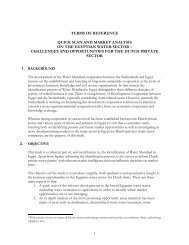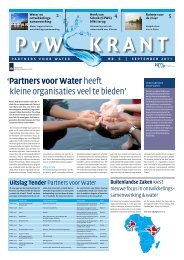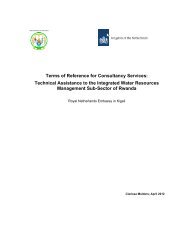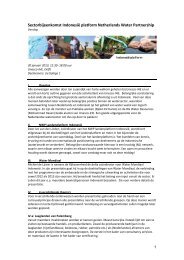Scoping mission on water in rwanda - Partners voor Water
Scoping mission on water in rwanda - Partners voor Water
Scoping mission on water in rwanda - Partners voor Water
Create successful ePaper yourself
Turn your PDF publications into a flip-book with our unique Google optimized e-Paper software.
<str<strong>on</strong>g>Scop<strong>in</strong>g</str<strong>on</strong>g> Missi<strong>on</strong> <strong>on</strong> Rwanda for Embassy of the K<strong>in</strong>gdom of the Netherlands, Kigali<br />
2 Present situati<strong>on</strong> <strong>in</strong> <strong>water</strong> sector<br />
2.1 <strong>Water</strong> sector <strong>in</strong> Rwanda<br />
2.1.1 IWRM<br />
• The importance of IWRM for Rwanda has been under-valued. <strong>Water</strong> development has been approached from<br />
a pragmatic, service-oriented more than from a susta<strong>in</strong>able development and utilisati<strong>on</strong> of a f<strong>in</strong>ite resource<br />
perspective. Ma<strong>in</strong> <strong>water</strong> users such as agriculture, energy from hydro-power and <strong>water</strong> supply work nearly<br />
<strong>in</strong>dependently <strong>in</strong> their own doma<strong>in</strong>s without significant coord<strong>in</strong>ati<strong>on</strong> with other sectors <strong>in</strong> us<strong>in</strong>g the same<br />
source. Each of these big <strong>water</strong> users has not taken the c<strong>on</strong>cerns of the other users seriously <strong>in</strong>to account.<br />
Now as Rwanda has high targets to <strong>in</strong>crease food producti<strong>on</strong>, to generate more energy and <strong>in</strong>crease <strong>water</strong><br />
c<strong>on</strong>sumpti<strong>on</strong>, these <strong>water</strong>-related sectors understand that they have to collaborate. The impressi<strong>on</strong> is that<br />
they major their own sectors over the others and do not fully appreciate the opportunities and risks for the<br />
source from their own and the other sectors’ side. The Rwandan Natural Resources Authority (2010) has<br />
now a directorate <strong>on</strong> <strong>water</strong> resources management that is taken up this coord<strong>in</strong>ati<strong>on</strong> role of WRM and make<br />
that <strong>in</strong>tegrated <strong>in</strong> the development agenda of Rwanda, thereby supported by a very recent Policy and<br />
Strategic Plan, yet to be approved by the Cab<strong>in</strong>et. These two documents support the seriousness of the<br />
Government to address the fragility of <strong>water</strong> as a resource <strong>in</strong> a susta<strong>in</strong>able social and ec<strong>on</strong>omic development,<br />
be<strong>in</strong>g reflected <strong>in</strong> the Visi<strong>on</strong> 2020 and the EDPRSP 2008-12. Three key characteristics of WRM stand out: the<br />
wide spectrum of users, the <strong>water</strong> quality and <strong>water</strong> quantity.<br />
• IWRM from the perspective of the various ma<strong>in</strong> <strong>water</strong> user categories:<br />
(i) Households use small amounts of <strong>water</strong> and demand safe <strong>water</strong> for dr<strong>in</strong>k<strong>in</strong>g and domestic purposes.<br />
They may also c<strong>on</strong>tam<strong>in</strong>ate and pollute surface and ground<strong>water</strong> through improper human waste handl<strong>in</strong>g.<br />
Rwanda’s populati<strong>on</strong> is relative large and grow<strong>in</strong>g at a relatively high rate of some 2.8 % per year. The future<br />
domestic requirements <strong>in</strong> <strong>water</strong> volume also result<strong>in</strong>g from an <strong>in</strong>creas<strong>in</strong>g c<strong>on</strong>sumpti<strong>on</strong> and <strong>in</strong> quality set<br />
criteria for raw <strong>water</strong> sources also <strong>in</strong> view of the limited feasible technological and f<strong>in</strong>ancial c<strong>on</strong>diti<strong>on</strong>s of the<br />
communities.<br />
(ii) Agriculture uses <strong>water</strong> from various sources: ra<strong>in</strong>, lakes, rivers and ground. Marshland will<br />
<strong>in</strong>creas<strong>in</strong>gly be used for irrigati<strong>on</strong>, which may – if not d<strong>on</strong>e <strong>in</strong> a balanced way – damage the ecological<br />
functi<strong>on</strong>s these wetlands have and cause serious problems <strong>in</strong>clud<strong>in</strong>g floods and dry<strong>in</strong>g-up of lakes, as<br />
experienced already 1 . The recognised need to steeply <strong>in</strong>crease the irrigated land porti<strong>on</strong> will demand for<br />
<strong>in</strong>novative technological <strong>water</strong> provisi<strong>on</strong> soluti<strong>on</strong>s if not to threaten the <strong>water</strong> demands by other users.<br />
<strong>Water</strong> use efficiency is very low, both <strong>in</strong> traditi<strong>on</strong>al agricultural and irrigati<strong>on</strong> systems. Intensive agriculture<br />
has the potential risk to cause serious <strong>water</strong> polluti<strong>on</strong> from <strong>in</strong>tensive use of fertilisers and pesticides.<br />
Pastoralism is banned <strong>in</strong> Rwanda and livestock is <strong>on</strong>ly at the farms but still promoted. Fisheries development<br />
depends <strong>on</strong> lakes and rivers and is not viewed as a major ec<strong>on</strong>omic development pillar.<br />
(iii) Electricity access is limited now but by 2020 some 35% of populati<strong>on</strong> will be c<strong>on</strong>nected (accord<strong>in</strong>g to<br />
Visi<strong>on</strong> 2020). Hydropower will be a major c<strong>on</strong>tributor to the power demand and impact <strong>on</strong> the <strong>water</strong><br />
availability situati<strong>on</strong> <strong>in</strong> the <strong>water</strong> bas<strong>in</strong>s. Planned large-scale methane gas explorati<strong>on</strong> from lakes may have<br />
adverse effects <strong>on</strong> the lakes’ <strong>water</strong> quality.<br />
(iv) Industry both requires <strong>water</strong> and produces <strong>in</strong>dustrial effluents, which, if not treated adequately, may<br />
seriously pollute receiv<strong>in</strong>g surface <strong>water</strong> mak<strong>in</strong>g these unfit for other uses and impact<strong>in</strong>g <strong>on</strong> the ecology.<br />
Coffee is a grow<strong>in</strong>g <strong>in</strong>dustry; coffee process<strong>in</strong>g is a serious <strong>water</strong> c<strong>on</strong>sumer and pollut<strong>in</strong>g activity that – at this<br />
moment - hardly <strong>in</strong>cludes waste<strong>water</strong> treatment. The nati<strong>on</strong>al <strong>in</strong>vestment policy is to attract <strong>in</strong>dustries and<br />
develop a service sector to support the ec<strong>on</strong>omic development, also as by 2020 agriculture may <strong>on</strong>ly employ<br />
some 50% (2008: 90%) of the populati<strong>on</strong>.<br />
1 some lakes have also been restored such as Lake Cyohoha, Rugezi wetland supply<strong>in</strong>g lakes Burera and Ruh<strong>on</strong>do<br />
Page 4
















